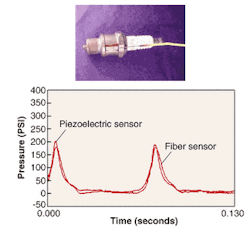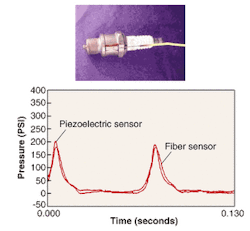Spark-plug interferometer senses cylinder pressure
To wring every last bit of efficiency from internal-combustion (IC) engines, automotive engineers need to know, experimentally and accurately, just what goes on within those cylinders. Such information both verifies and provides grist for theory. Now, researchers at Texas A&M University (College Station, TX) have integrated an interferometric fiberoptic sensor into a spark plug to provide pressure sensing within an IC-engine cylinder.1 And the spark plug is no dummy—it provides spark to the cylinder as well.
An intrinsic fiber Fabry-Perot interferometer (FPPI) was fabricated by depositing two low-reflectance titanium dioxide mirrors on each end of a single-mode-fiber segment, one on each end. The segment was then fusion-spliced into a longer segment of fiber; the mirrors became part of the fiber, forming a low-finesse cavity. The fiber was coated with both gold and copper and a break intentionally induced in the end beyond the cavity to reduce reflection from the unused end. The coated fiber was then bonded into a groove cut into a conventional spark plug (see figure). The fiber exits the assembly in a steel tube bonded to the spark plug in a larger groove.
When the cylinder under test fires, the spark plug casing undergoes longitudinal strain, which also strains the fiber. Chirped pulses from a 1.3-µm-emitting distributed-feedback laser are sent into the cavity at a 2-kHz rate; the return signal is detected by a photodiode. A microprocessor tracks the fringes.
Four sensors, calibrated with a so-called dead-weight tester, exhibited sensitivities of 0.00339, 0.00325, 0.00248, and 0.00189 rad/psi. Because the spark plug was not cooled, the sensors were subjected to the full heat produced by the cylinder; all sensors lasted several hours in the cylinder. In-cylinder measurements matched closely with those from a piezoelectric sensor used for comparison. Henry Taylor, one of the researchers, notes that the fiber sensor survives much better at high temperatures than piezoelectric pressure sensors and also requires less-frequent calibration. "Further, our fiberoptic sensor is not cooled, whereas the piezos generally require water cooling," he says.
The fiber sensor is only 150 µm in diameter, making it easy to fit in. As well as testing, the sensor may be useful in engine-control systems for reducing IC-engine emissions and boosting fuel economy.
REFERENCE
- Taehan Bae et al., Applied Optics (Feb. 20, 2003).

